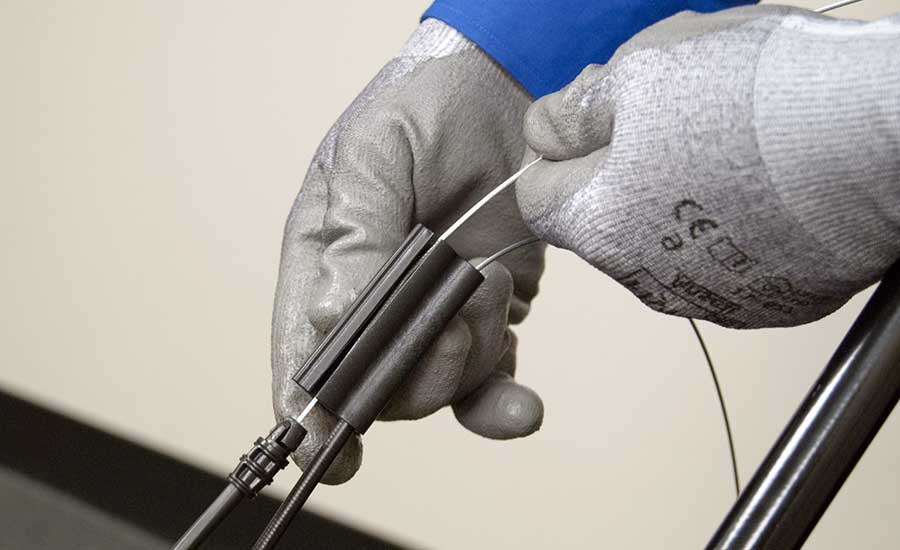If your self-propelled lawn mower isn’t moving, the cable might be the culprit. This how-to guide will show you how to fix a self-propelled lawn mower cable in just a few easy steps. Keep in mind that this guide is for informational purposes only and we recommend seeking professional help if you are unsure about how to complete any of these steps.

How To Replace a Lawn Mower’s Cable?
Cable problems are one of the most common issues with self-propelled lawn mowers. Fortunately, they are also one of the simplest to repair. In most cases, all you need is a screwdriver and a pair of pliers. First, locate the problem area. The cable may be frayed, kinked, or simply disconnected. If the problem is a simple disconnection, simply reattach the cable. If the problem is more serious, you may need to replace the entire cable. Please refer to your owner’s manual for further instructions. With a little time and effort, you should be able to get your lawn mower running like new again.
Why is my self propelled mower not propelling?
One of the most frustrating things that can happen when you’re trying to mow your lawn is when yourself propelled mower stops propelling itself. There are a few different reasons why this might happen, but the most common one is that the drive belt has come off. Another possibility is that the drive wheels are not properly engaged with the ground. If this is the case, you may need to adjust the wheels so that they have better traction. Finally, if the mower is not getting enough power, it may be time to replace the battery. By troubleshooting the problem and taking some simple steps, you can usually get yourself propelled mower back up and running again in no time.
How do you adjust a self-propel cable?
Assuming you are referring to a self-propelled lawn mower, the adjustment process is actually quite simple. Most mowers have a knob or lever near the handle that can be used to adjust the cable tension. loosening the knob or lever will result in less tension on the cable, while tightening it will increase the tension.
It is important to find the right balance, as too much tension can damage the cable, while too little tension will make it difficult for the mower to move forward. Once you have found the ideal setting, be sure to tighten the knob or lever securely to prevent it from slipping during use. With a little trial and error, you should be able to easily adjust the self-propel cable on your lawn mower.
How do you fix the power cord on a lawn mower?
If your lawn mower power cord is frayed or damaged, it is important to fix it as soon as possible. A frayed power cord can cause electrocution or fire and should be replaced immediately. To replace a damaged power cord, first unplug the lawn mower from the power outlet. Then, cut the damaged section of cord using a pair of wire cutters. Strip the insulation off of the end of the cut wires using a wire stripper. Finally, twist each wire around a connector terminal and screw on the terminal caps. Once the new cord is connected, plug in the lawn mower and test it to make sure it is working properly.
Also Read: How to Attach a Toro Lawn Mower Bag
How to adjust the cable on a Honda self-propelled lawn mower?
The cable on a Honda self-propelled lawn mower can be adjusted in a few simple steps. First, loosen the bolt that secures the cable to the housing. Next, rotate the housing until the cable is tight. Finally, retighten the bolt to secure the cable in place. This process can be repeated as needed to keep the cable taut and ensure proper operation of the lawn mower.
How much does it cost to fix a self-propelled lawn mower? It depends on the problem.
This is a question that many people ask when they are having problems with their lawn mower. The answer to this question depends on the problem that you are having with your lawn mower. If the problem is something minor, such as a clogged air filter, then the cost to fix it will be relatively low. However, if the problem is more serious, such as a broken engine, then the cost to fix it will be much higher. In general, the cost to fix a self-propelled lawn mower will vary depending on the severity of the problem.
Can you push self-propelled lawn mower?
The answer is more complicated than it appears. On the one hand, self-propelled lawn mowers are designed to be pushed, so it stands to reason that you should be able to do so without any problems. However, on the other hand, self-propelled lawn mowers often have a lever or knob that needs to be engaged in order for the wheels to turn.
So, while you may be able to physically push the lawn mower, it may not actually move unless the lever or knob is engaged. In short, it depends on the design of the self-propelled lawn mower in question. Therefore, it is always best to consult your owner’s manual before attempting to push a self-propelled lawn mower.
5 possible explanations for why your lawn mower’s wheels aren’t self-propelled
If you’ve ever had a lawn mower that refused to move on its own, you know how frustrating it can be. Fortunately, there are a few reasons why this might happen – and a few ways to fix it. Here are 5 reasons why your lawn mower’s wheels aren’t being self-propelled:
- The transmission could be damaged. If the transmission is damaged, the wheels won’t be able to turn. This is a common problem with self-propelled lawn mowers, and it can usually be fixed by replacing the transmission.
- The drive belt could be worn out. The drive belt is what turns the wheels when you’re pushing the mower. If it’s worn out, it won’t be able to create enough friction to turn the wheels. You’ll need to replace the drive belt to fix this problem.
- The bearings could be worn out. The bearings allow the wheels to rotate freely. If they’re worn out, they’ll create too much resistance for the transmission to overcome. You’ll need to replace the bearings to fix this problem.
- The ground could be too soft. If the ground is too soft, it won’t provide enough resistance for the wheels to turn. This is a common problem in muddy or sandy conditions. The only way to fix it is to wait for the ground to dry out or firm up.
- There could be something blocking the wheels. If something is blocking the wheels, they won’t be able to turn. Make sure there’s nothing caught in them before you try to move the mower again.
